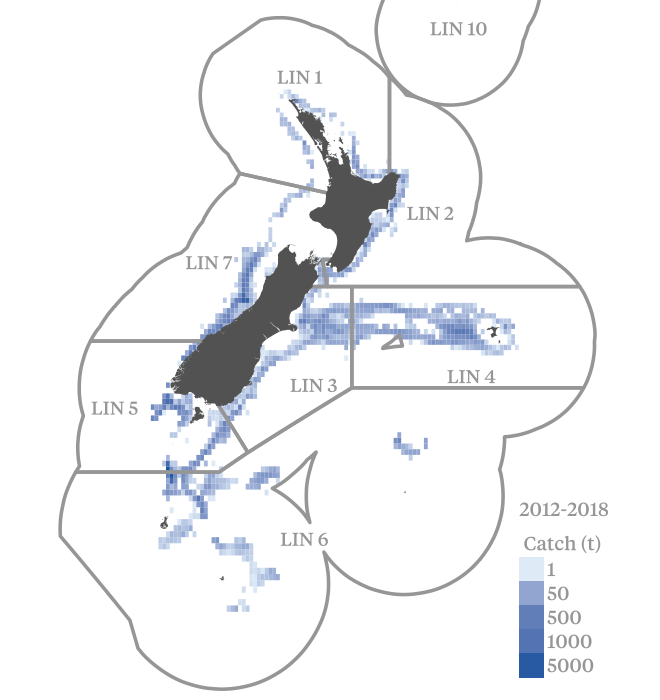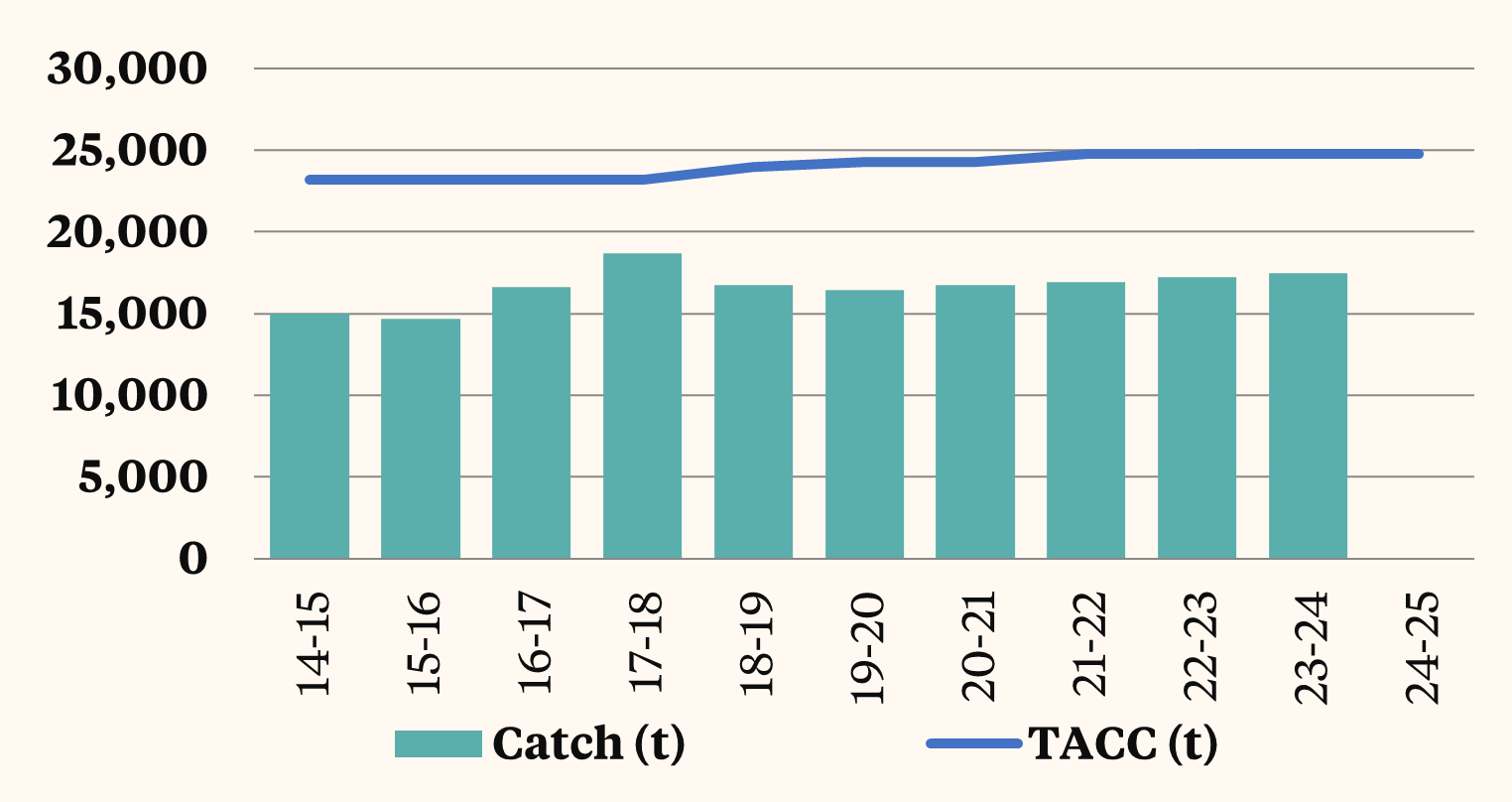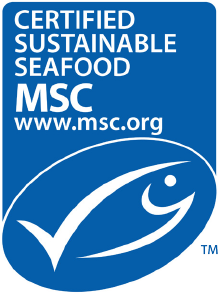Hokarari, Kingklip, Pink Ling
The New Zealand ling trawl and longline fishery is a well managed and sustainable fishery in accordance with the Marine Stewardship Council's Principles and Criteria for Sustainable Fishing.
The fishery operates in five main areas of New Zealand (LIN 3, LIN 4, LIN 5, LIN 6 and LIN 7) where ling are widely distributed throughout the middle depths (200 – 800 m). Ling live to a maximum age of about 30 years.
Ling are largely caught as part of the hoki/hake/ling trawl fishery complex. Hoki and hake are both MSC-certified fisheries. There is also an increasing target fishery for ling using bottom longline.
Ling is managed by Fisheries New Zealand (FNZ) using the Quota Management System (QMS). FNZ works in partnership with Seafood New Zealand | Deepwater Council (a not-for-profit organisation that works on behalf of fisheries quota owners). The two parties developed a joint-management framework with agreed strategic and operational priorities and work plans. The partnership is focused on determining the maximum economic yield of the deepwater fisheries by setting catch limits that maximise returns over the long term within the constraints of ecological sustainability.
The MSC Certification covers about 93% of all ling caught in New Zealand. Ling was re-certified in September 2018.
For more information, download the full MSC Certification Report (Trawl) and (Longline).
The MSC scheme follows international benchmarks to promote robust processes and uphold values of independence, transparency, impartiality and stakeholder consultation.
The MSC assessment process is run by an independent certification body (accredited by Accreditation Services International GmbH). A group of auditors (with expertise in the fishery and ecosystems under consideration) are responsible for scoring the performance of the fishery based on scientific evidence. Auditors must meet the qualifications and competencies set out in the MSC Certification Requirements.
In order to achieve MSC certification, a fishery must pass 28 performance indicators within three core principles: sustainable stocks, minimising environmental impact and effective management.
The certification process takes between 6 and 18 months. The assessment process includes opportunities for stakeholder input and peer review. Certification lasts up to 5 years, during which time the fishery makes any improvements required as a condition of certification. Annual audits are carried out by the certifier to ensure continued compliance. A full reassessment of the fishery must be completed within five years of the last certificate being granted.
The information presented on this page is extracted from the MSC Public Certification Report and most recent Surveillance Audit Report. More information can be found at www.msc.org


Assessment Summary

Sustainable target fish stocks
Principle 1 states a fishery must be conducted in a manner that does not lead to over-fishing or depletion of the exploited populations and, for those populations that are depleted, the fishery must be conducted in a manner that demonstrably leads to their recovery.
All five ling stocks are at a level that maintains high productivity and has a low probability of overfishing. The report of the Stock Assessment Plenary (and individual stock assessment reports) summarises information on stock structure and biology of ling, including growth, natural mortality, and maturity. Stock abundance is estimated from a stock assessment, which requires data on catches, abundance indices, age, and size composition. Sufficient data are all available to obtain good estimates of stock abundance from the assessment.
Environmental impact of fishing
Principle 2 states that fishing operations should allow for the maintenance of the structure, productivity, function, and diversity of the ecosystem (including habitat and associated dependent and ecologically related species) on which the fishery depends.
A management strategy is in place for the ling fishery that is highly likely to achieve national and international requirements for the protection of endangered, threatened and protected species, particularly seabirds and marine mammals. This is supported by industry codes of conduct and vessel operational procedures for mitigating interactions with seabirds and marine mammals.
The ling trawl fishery is not thought by experts to represent an especially high risk for seabird populations, as long as effective management measures, including mitigation, are in place. By law, trawlers over 28 m in length fishing in New Zealand waters are required to use one of three specified devices to reduce seabird interactions with trawl warps; paired streamer lines, a bird baffler or a warp scarer. The larger auto liners operate under conservation measures set by the Commission for the Conservation of Antarctic Marine Living Resources (CCAMLR). These have various bird bycatch mitigation controls, which are highly effective.
Interactions between the ling trawl fishery and marine mammals are typically with fur seals. Fur seal populations are monitored, and estimates of total New Zealand population sizes, and number of breeding colonies are generally increasing. Overall, the ling trawl fisheries are highly unlikely to directly affect the growing population, although continued study is warranted. No fur seal interactions have been observed in the ling longline fishery. No interactions with sea lions or dolphins have been noted.
Effective management
Principle 3 requires that a fishery is subject to an effective management system that respects local, national, and international laws and standards and incorporates institutional and operational frameworks that require the use of the resource to be responsible and sustainable.
The ling management system has an effective monitoring, control and surveillance system, including satellite vessel monitoring systems, government observers, and accurate reporting and record-keeping. Sanctions to deal with non-compliance in the fishery exist, and are consistently applied. However, the preferred approach is to work collaboratively with industry to prevent non-compliance.
The National Fisheries Plan for Deepwater has specific objectives for ling that directly guide actions in the fishery. These are specified in the Annual Operating Plan and progress reported in the Annual Review Report.
The ling fishery has been managed within the QMS since its inception in 1986.
Summary of assessment conditions
There are no conditions.

